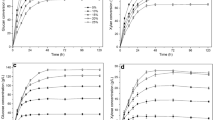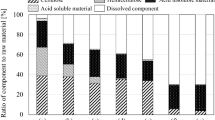Abstract
A process for production of fuel ethanol from bamboo treated with concentrated sulfuric acid has been previously proposed. To improve efficiency of the process, we tested saccharification with 70 weight% (wt%) sulfuric acid, acid–sugar separation by ion exclusion, addition of nutrients to the ethanol fermentation, and bioconversion of xylose to xylitol. A high efficiency of both sugar recovery (82.5 %) and acid recovery (97.5 %) was achieved in the saccharification process and in the continuous acid–sugar separation using a modified anion exchange resin, respectively. Reduction of the amount of mineral salts added to the saccharified liquid after acid–sugar separation did not negatively affect performance of the continuous ethanol fermentation. The ethanol yield and productivity were 93.7 % and 6 g/l h, respectively, at 35 °C and pH 4.0. And the ethanol yield and productivity were almost the same even at pH 3.5. Moreover, the xylose remaining in the fermented mash was efficiently converted to xylitol in batch fermentation by Candida tropicalis strain 2.1776. These results demonstrate a more efficient process for the production of fuel ethanol from bamboo.






Similar content being viewed by others
References
Scurlock JMO, Dayton DC, Hames B (2000) Bamboo: an overlooked biomass resource? Biomass Bioenergy 19:229–244
Saka S (2001) Biomass energy environment. Industrial Publishing and Consulting, Tokyo, pp 61–103
Zhang XY, Yu HB, Huang HY, Liu YX (2007) Evaluation of biological pretreatment with white rot fungi for the enzymatic hydrolysis of bamboo culms. Int Biodeterior Biodegrad 60:159–164
Tomitaka M, Taguchi H, Fukuda K, Akamatsu T, Kida K (2013) Isolation and characterization of a mutant recombinant Saccharomyces cerevisiae strain with high efficiency xylose utilization. J Biosci Bioeng 116:706–715
Sathitsuksanoh N, Zhu ZG, Ho TJ, Bai MD, Zhang YHP (2010) Bamboo saccharification through cellulose solvent-based biomass pretreatment followed by enzymatic hydrolysis at ultra-low cellulase loadings. Bioresour Technol 101:4926–4929
Shimokawa T, Ishida M, Yoshida S, Nojiri M (2009) Effects of growth stage on enzymatic saccharification and simultaneous saccharification and fermentation of bamboo shoots for bioethanol production. Bioresour Technol 100:6651–6654
Sun Y, Lin L (2010) Hydrolysis behavior of bamboo fiber in formic acid reaction system. J Agric Food Chem 58:2253–2259
Yamashita Y, Shono M, Sasaki C, Nakamura Y (2010) Alkaline peroxide pretreatment for efficient enzymatic saccharification of bamboo. Carbohydr Polym 79:914–920
Sun ZY, Tang YQ, Iwanaga T, Sho T, Kida K (2011) Production of fuel ethanol from bamboo by the concentrated sulfuric acid hydrolysis followed by continuous ethanol fermentation. Bioresour Technol 102:10929–10935
Sun ZY, Tang YQ, Morimura S, Kida K (2013) Reduction in environmental impact of sulfuric acid hydrolysis of bamboo for production of fuel ethanol. Bioresour Technol 128:87–93
Miller S, Hester R (2007) Concentrated acid conversion of pine softwood to sugars. Part I: use of a twin-screw reactor for hydrolysis pretreatment. Chem Eng Comm 194:85–102
Perry JH (1942) Chemical engineers’ handbook, 3rd edn. McGraw-Hill, New York
Matsuura H, Sun ZY, Yanase M, Ihara T, Kida K, Jyo A (2014) Separation of sulfuric acid and monosaccharides with a strong-base anion exchange resin containing polystyrene sulfonate as polymeric counter ion to reduce tailing of sulfuric acid. J Ion Exch 25:81–87
Kida K, Morimura S, Kume K, Suruga K, Sonoda Y (1991) Repeated-batch ethanol fermentation by a flocculating yeast Saccharomyces cerevisiae IR-2. J Ferment Bioeng 71:340–344
Kida K, Morimura S, Kume K, Sonoda Y (1992) Repeated-batch fermentation process using a thermotolerant flocculating yeast constructed by protoplast fusion. J Ferment Bioeng 74:169–173
Liu ZS, Wu XL, Kida K, Tang YQ (2012) Corn stover saccharification with the concentrated sulfuric acid: effects of saccharification conditions on sugar recovery and by-products generation. Bioresour Technol 119:224–233
Sluiter A, Hames B, Ruiz R, Scarlata C, Sluiter J, Templeton D (2005) Determination of ash in biomass. Laboratory analytical procedure (LAP). NREL/TP-510-42622. National Renewable Energy Laboratory, Golden, Colorado
Sluiter A, Hames B, Ruiz R, Scarlata C, Sluiter J, Templeton D, Crocker D (2008) Determination of structural carbohydrates and lignin in biomass. Laboratory analytical procedure (LAP). NREL/TP-510-42618. National Renewable Energy Laboratory, Golden, Colorado
Japanese Industrial Standards Committee (1986) Testing methods for industrial wastewater, JIS K 0102-1986. Japanese Industrial Standards Committee, Tokyo
Tang YQ, An MZ, Liu K, Nagai S, Shigematsu T, Morimura S, Kida K (2006) Ethanol production from acid hydrolysate of wood biomass using the flocculating yeast Saccharomyces cerevisiae strain KF-7. Process Biochem 41:909–914
Kida K, Morimura S, Sonoda Y (1993) Accumulation of Propionic Acid during Anaerobic Treatment of Distillery Wastewater from Barley-Shochu Making. J Ferment Bioeng 75:213–216
Kadam KL, Newman MM (1997) Development of a low-cost fermentation medium for ethanol production from biomass. Appl Microbiol Biotechnol 47:625–629
Kida K, Yamadaki M, Asano S, Nakata T, Sonada Y (1989) The effect of aeration on stability of continuous ethanol fermentation by a flocculating yeast. J Ferment Bioeng 68:107–111
Walther T, Hensirisak P, Agblevor FA (2001) The influence of aeration and hemicellulosic sugars on xylitol production by Candida tropicalis. Bioresour Technol 76:213–220
Ping Y, Ling HZ, Song G, Ge JP (2013) Xylitol production from non-detoxified corncob hemicellulose acid hydrolysate by Candida tropicalis. Biochem Eng J 75:86–91
Ko CH, Chiang PN, Chiu PC, Liu CC, Yang CL, Shiau IL (2008) Integrated xylitol production by fermentation of hardwood wastes. J Chem Technol Biotechnol 83:534–540
Cheng KK, Zhang JA, Ling HZ, Ping WX, Huang W, Ge JP, Xu JM (2009) Optimization of pH and acetic acid concentration for bioconversion of hemicelluloses from corncobs to xylitol by Candida tropicalis. Biochem Eng J 43:203–207
Huang CF, Jiang YF, Guo GL, Hwang WS (2011) Development of a yeast strain for xylitol production without hydrolysate detoxification as part of the integration of co-product generation within the lignocellulosic ethanol process. Bioresour Technol 102:3322–3329
Kotter P, Ciriacy M (1993) Xylose fermentation by Saccharomyces cerevisiae. Appl Microbiol Biotechnol 38:776–783
Li YC, Liu ZS, Gou ZX, Tang YQ, Akamatsu T, Kida K (2014) Synergistic effects of TAL1 overexpression and PHO13 deletion on the weak acid inhibition of xylose fermentation by industrial Saccharomyces cerevisiae strain. Biotechnol Lett 36:2011–2021
Cai Z, Zhang B, Li Y (2011) Engineering Saccharomyces cerevisiae for efficient anaerobic xylose fermentation: Reflections and perspectives. Biotechnol J 7:34–46
Prakash G, Varma AJ, Prabhune A, Shouche Y, Rao M (2011) Microbial production of xylitol from D-xylose and sugarcane bagasse hemicelluloses using newly isolated thermotolerant yeast Debaryomyces hansenii. Bioresour Technol 102:3304–3308
Acknowledgements
The authors thank Prof. Akinori Jyo at Kumamoto University for supplying the modified anion exchange resin, DOWEX 1 × 4 SS. This work was supported financially by the Ministry of the Environment of Japan.
Author information
Authors and Affiliations
Corresponding author
Electronic supplementary material
Below is the link to the electronic supplementary material.
Rights and permissions
About this article
Cite this article
Sun, ZY., Wang, T., Tan, L. et al. Development of a more efficient process for production of fuel ethanol from bamboo. Bioprocess Biosyst Eng 38, 1033–1043 (2015). https://doi.org/10.1007/s00449-014-1345-8
Received:
Accepted:
Published:
Issue Date:
DOI: https://doi.org/10.1007/s00449-014-1345-8




